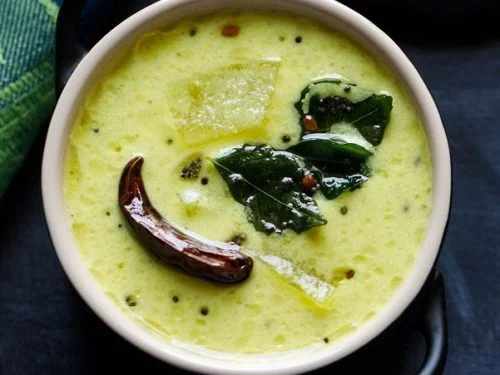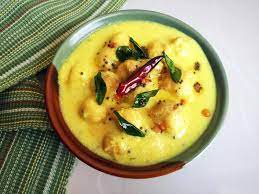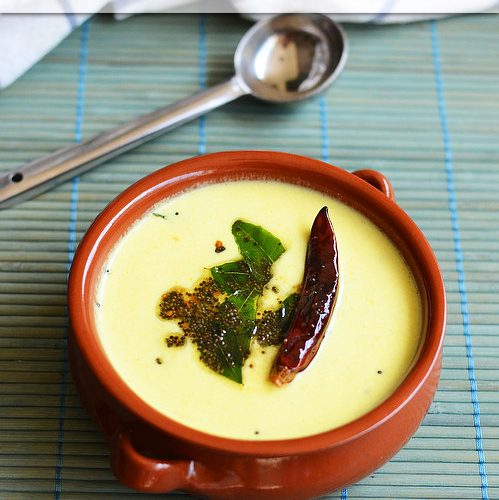About
South Indian cuisine is celebrated for its rich flavors and diverse dishes. One such delectable creation is Mor Kulambu, a yogurt-based curry that tantalizes the taste buds with its unique blend of tanginess and creaminess. In this comprehensive guide, we will delve into the world of Mor Kulambu, exploring its history, ingredients, and preparation, and answering frequently asked questions to ensure you can master this culinary delight with ease
Mor Kulambu Recipe:

Mor Kulambu, also known as Mor Kuzhambu, is a traditional South Indian curry hailing from Tamil Nadu. It is characterized by its distinct tangy taste, owing to the use of yogurt and a medley of spices. This recipe is a favorite among South Indian households and is often enjoyed with steamed rice. Let's dive into the step-by-step preparation of this delectable dish.
Ingredients
- 1 cup of yogurt
- 1/4 cup of grated coconut
- 1 tablespoon of tuvar dal (split pigeon peas)
- 1 teaspoon of cumin seeds
- 1/2 teaspoon of fenugreek seeds
- 1/2 teaspoon of turmeric powder
- 2-3 green chilies
- 1/4 cup of water
- Salt to taste
- A pinch of asafoetida
- Curry leaves for garnish
- 1 tablespoon of coconut oil
Instructions
- Preparation of Coconut Paste: Grind the grated coconut, tuvar dal, cumin seeds, and fenugreek seeds into a fine paste. Add a little water to achieve the desired consistency.
- Whisking the Yogurt: Take the yogurt in a bowl and whisk it until smooth.
- Mixing Coconut Paste with Yogurt: Combine the coconut paste with the yogurt and mix well.
- Tempering: In a separate pan, heat coconut oil. Add mustard seeds and let them splutter. Add asafoetida, green chilies, and curry leaves. Sauté briefly.
- Combining the Ingredients: our the yogurt-coconut mixture into the pan. Add turmeric powder and salt to taste. Allow the mixture to simmer on low heat for about 5-7 minutes, stirring continuously.
- Finishing Touch: Once the Mor Kulambu thickens slightly and emits a pleasant aroma, remove it from the heat.
- Serving: Serve Mor Kulambu hot with steamed rice. It also pairs well with dosa or idli.
Notes
- Always use fresh yogurt and coconut for the best flavor. Fresh ingredients can make a significant difference in the taste of your Mor Kulambu.
- Make sure to whisk the yogurt until it's smooth and free from lumps. This ensures a creamy consistency in the final dish.
- If you prefer a spicier Mor Kulambu, you can increase the number of green chilies. Conversely, if you like it milder, use fewer chilies or deseed them.
- The tempering process with mustard seeds, asafoetida, and curry leaves adds a wonderful aroma to the dish. Don't skip this step.
- When simmering the yogurt-coconut mixture, keep the heat low and stir continuously. This prevents the yogurt from curdling and maintains the creamy texture.
- Feel free to add vegetables like okra, ash gourd, or even drumsticks to enhance the flavor and texture of your Mor Kulambu.
- While traditional tempering is delicious, you can get creative with it. Some people add garlic or shallots for extra depth of flavor.
- Mor Kulambu is best enjoyed hot with steamed rice, dosa, or idli. The flavors are at their peak when freshly prepared.
- Like any other dish, practice makes perfect. Don't be discouraged if your first attempt isn't flawless. With each try, you'll refine your technique.
- Cooking is not just about the end result; it's also about enjoying the process. Have fun experimenting with Mor Kulambu and savor the flavors of South India.
Nutrition Information:
Serving Size:
1 cup or 240 ml:Amount Per Serving: Calories: 100-120Total Fat: 5-7gSodium: 200-300mgCarbohydrates: 10-12gFiber: 1-2gProtein: 4-6g
Variations
- Enhance the nutritional value by adding vegetables like okra, ash gourd, or drumsticks. These additions bring a delightful crunch and flavor to your recipe.
- For a protein-packed version, toss in cooked chickpeas. They add a hearty texture and make the dish more filling.
- If you prefer a lighter version, skip the grated coconut in the coconut paste. This variation is perfect for those looking to reduce calorie intake.
- Increase the number of green chilies or add red chili powder to make your recipe spicier. Adjust the spice level to suit your taste.
- Introduce tangy tomatoes to the mix. Tomatoes not only enhance the flavor but also add a lovely color to the dish.
Pairing Suggestions:
- Mor Kulambu is traditionally served with steamed rice. The creamy and tangy curry complements the mild taste of rice perfectly.
- Soft and fluffy idlis make an excellent pairing with Mor Kulambu. The combination of textures and flavors is delightful.
- Crispy dosas, whether plain or stuffed, are a great accompaniment. The contrast between the crispy dosa and the creamy curry is a treat for your taste buds.
- Appam, a South Indian pancake, pairs wonderfully with Mor Kulambu. The spongy center and crispy edges of Appam soak up the flavorful curry.
- If you prefer bread, whole wheat chapati or roti is a healthier option to enjoy with Mor Kulambu.
- A fragrant vegetable pulao can be a delightful pairing. The mildness of the pulao complements the tangy curry.
- Jeera rice, or cumin rice, offers a fragrant and mildly spiced option to enjoy with Mor Kulambu.
Serving Suggestions:
- Sprinkle some freshly chopped coriander or curry leaves on top of Mor Kulambu for added freshness and aroma.
- Serve it with lemon wedges on the side. Squeezing a bit of lemon juice over the curry can enhance its tangy flavor.
- A side of South Indian pickle, such as mango pickle or lemon pickle, can add an extra layer of flavor to your meal.
- Crispy pappadum or papad can be served as a crunchy accompaniment to the creamy curry.
- If you’re serving Mor Kulambu with dosa or idli, a side of coconut chutney can complement the flavors nicely.
- For an authentic touch, heat some oil and add mustard seeds and curry leaves. Drizzle this tadka over the recipe just before serving.
- You can add a variety of sautéed or steamed vegetables to the plate for added nutrition and texture.
- Cooling cucumber raita can balance the spiciness if you’ve opted for a spicier version of Mor Kulambu.
FAQs (Frequently Asked Questions)
Q: What is the origin of Mor Kulambu?
A: Thet has its roots in Tamil Nadu, a state in South India. It is a traditional dish prepared in Tamil households for generations.
Q: Can I use store-bought yogurt for this recipe?
A: Yes, you can use store-bought yogurt. However, using fresh homemade yogurt enhances the flavor of Mor Kulambu.
Q: Is Mor Kulambu a spicy dish?
A: This recipe is mildly spicy due to the addition of green chilies, but it is primarily known for its tangy and creamy taste.
Q: Can I customize the spice level?
A: Certainly! You can adjust the number of green chilies to suit your spice preferences. If you like it spicier, add more chilies; for a milder version, use fewer.
Q: What are some common variations of Mor Kulambu?
A: Some variations include adding vegetables like okra or ash gourd for added texture and flavor. You can also experiment with different tempering ingredients.
Q: Is Mor Kulambu a healthy dish?
A: Yes, it is considered healthy as it contains yogurt, which is a good source of probiotics and protein. It’s also low in calories.
Conclusion
Mor Kulambu is a delightful South Indian dish that offers a perfect balance of flavors. With its tangy and creamy taste, it’s a favorite comfort food in many households. By following this comprehensive guide, you can now prepare Mor Kulambu with confidence. Customize the spice level, add your favorite vegetables, and enjoy this culinary masterpiece that showcases the rich heritage of South Indian cuisine.
You Might Also Like:
- Aate ka Halwa Recipe:
- Indian Tricolour Cupcake
- Kheer Mohan Recipe:
- Mysore Pak Recipe
- Badam Katli Recipe
- Rabdi malpua recipe:
follow us on Instagram, Facebook, and youtube





